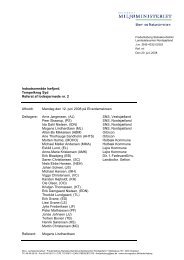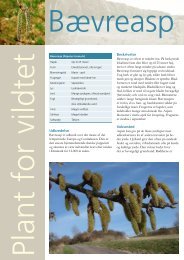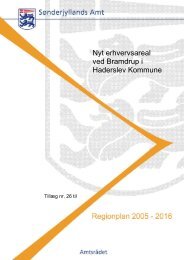Macroalgae and phytoplankton as indicators of ... - Naturstyrelsen
Macroalgae and phytoplankton as indicators of ... - Naturstyrelsen
Macroalgae and phytoplankton as indicators of ... - Naturstyrelsen
Create successful ePaper yourself
Turn your PDF publications into a flip-book with our unique Google optimized e-Paper software.
4.3 Evaluation <strong>of</strong> the precision <strong>of</strong> the chlorophyll a indicator<br />
described <strong>as</strong> 'summer mean' <strong>and</strong> '90 th percentile'<br />
Different <strong>indicators</strong> have been suggested to characterise <strong>phytoplankton</strong><br />
biom<strong>as</strong>s. In the Baltic GIG summer means have been proposed, where<strong>as</strong><br />
the North E<strong>as</strong>t Atlantic GIG proposes to use the 90-percentile <strong>as</strong> indicator.<br />
The rationale behind these selections h<strong>as</strong> not been given careful considerations<br />
with respect to the statistical properties <strong>of</strong> indicator estimation.<br />
For the usefulness <strong>of</strong> <strong>indicators</strong>, two issues should be considered: 1)<br />
the responsiveness <strong>of</strong> the <strong>indicators</strong> to the pressure <strong>and</strong> 2) the precision<br />
<strong>of</strong> the indicator from sample sizes. In this section we will compare the<br />
two different <strong>indicators</strong> <strong>of</strong> <strong>phytoplankton</strong> biom<strong>as</strong>s by means <strong>of</strong> their precision<br />
given realistic sample sizes. We will examine these properties <strong>as</strong>suming<br />
chla to be described by parametric distributions (normal <strong>and</strong> lognormal)<br />
<strong>and</strong> non-parametric distribution using data from the national<br />
monitoring datab<strong>as</strong>e. The precision <strong>of</strong> the indicator will be <strong>as</strong>sessed by<br />
the st<strong>and</strong>ard error <strong>of</strong> the indicator estimation.<br />
The st<strong>and</strong>ard error <strong>of</strong> the mean is known to be inversely related to the<br />
square root <strong>of</strong> the sample size but such explicit relationships are more<br />
difficult to derive for percentiles. However, it is known that the variance<br />
<strong>of</strong> percentiles incre<strong>as</strong>es going from statistics describing the median to<br />
minimum <strong>and</strong> maximum values. Therefore, for different samples sizes (n<br />
= 10, 20, 30, …., 100) a st<strong>and</strong>ard normal <strong>and</strong> lognormal distribution w<strong>as</strong><br />
simulated 10000 times, <strong>and</strong> the mean, the median, 60-percentile, 70-<br />
percentile, 80-percentile <strong>and</strong> 90-percentile were calculated from these<br />
sample distributions. The st<strong>and</strong>ard error or the different statistics (<strong>indicators</strong>)<br />
w<strong>as</strong> estimated <strong>as</strong> the st<strong>and</strong>ard deviation <strong>of</strong> the 10000 replicates.<br />
The results using the two parametric distributions are in accordance with<br />
the theory <strong>of</strong> incre<strong>as</strong>ing st<strong>and</strong>ard error going from the mean over median<br />
to the 90-percentile (Figure 4.7). If data are normal distributed, then<br />
using the mean, estimated by the average <strong>of</strong> the sampled data, is by far<br />
the most precise indicator <strong>of</strong> the distribution. For the lognormal distribution<br />
the raw average <strong>of</strong> data is not the best estimator <strong>of</strong> the mean <strong>and</strong> it is<br />
actually more uncertain than the median <strong>and</strong> 60-percentile. This is due to<br />
the skewness <strong>of</strong> the lognormal distribution with high observations in the<br />
right tail that have a strong influence on the average. However, logtransforming<br />
the data prior to averaging <strong>and</strong> back-transforming the<br />
mean to the original scale gives the most precise indicator (Figure 4.7),<br />
because the log-transformation implicitly gives less weight to high observations<br />
<strong>and</strong> thereby reduce their influence on the mean statistic. Thus,<br />
the mean statistic is the most precise indicator for a sample distribution,<br />
provided that data can be approximated by a parametric distribution.<br />
This is also the re<strong>as</strong>on why the mean is used <strong>as</strong> parameter, <strong>and</strong> not the<br />
median or a percentile, for characterising statistical distributions.<br />
65
















